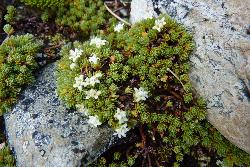- Taxon
- Gallery
- ≡ Drapetes dieffenbachii Hook., London Journal of Botany 497, t.17 (1843)
- = Drapetes tasmanica Hook.f. (1853)
- ≡ Kelleria tasmanica (Hook.f.) Berggr., Minneskr. Kongl. Fysiogr. Sällsk. Lund 8: 18 (1877)
- = Drapetes macrantha Colenso, Trans. & Proc. New Zealand Inst. 22: 487 (1889 [1890])
Plant forming dense to lax patches up to 25 cm. or more diam.; stems and branches prostrate and rooting, up to 3 mm. diam.; branchlets approximate, prostrate or ascending, glabrate, up to 5 cm. long. Lvs erect to appressed, sts incurved, 2.5–3·5 mm. long, obtuse, strongly concavo-convex, coriac., tapering from base 0·5–1 mm. wide; nerves prominent to obscure, margins ciliate, apex densely penicillate. Fls 3–8 per head; scales 4, sts 2-lobed or separated into 4 closely approximate pairs. Per. tube sparsely to densely pilose, 1·5–2.5 mm. long; lobes 1·5–2 mm. long, broad- to ovate-oblong, densely to sparsely pilose. Ovary ovoid, apex penicillate. Fr. ovoid, 1·5 mm. long.
[From: Allan (1961) Flora of New Zealand. Volume 1 as Drapetes dieffenbachii Hook.]




